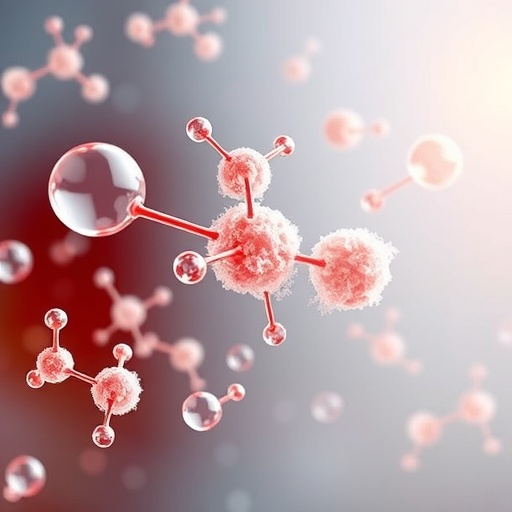In a groundbreaking study published in ACS Catalysis, scientists from Ruhr University Bochum in Germany have unveiled the intricate molecular mechanism of the bacterial membrane enzyme styrene oxide isomerase, unveiling a path to potentially revolutionary industrial applications. The enzyme, previously known to catalyze the conversion of toxic styrene oxide into phenylacetaldehyde, has long intrigued researchers due to its complex behavior within the bacterial membrane and its involvement in rare Meinwald rearrangement chemistry. This deepened understanding not only clarifies its biochemical role but also highlights its potential versatility for sustainable manufacturing processes.
Styrene oxide isomerase, an iron-containing heme enzyme embedded within bacterial membranes, has been a subject of study for over thirty years. However, its precise catalytic mechanism remained elusive because of challenges associated with its membrane anchoring and complex active site. The current investigation, led by doctoral student Selvapravin Kumaran under the guidance of Professor Dirk Tischler, has leveraged cutting-edge biochemical and structural analyses in collaboration with Delft University of Technology to decipher the enzyme’s nuanced function at the atomic level. Central to their findings is the discovery of the crucial role played by a specific amino acid residue—tyrosine—in driving the enzyme’s activity.
Previous research established that the enzyme features an iron-containing heme group crucial for catalysis. The new research expands this knowledge by demonstrating that the active site’s architecture involves an extremely precise spatial arrangement of the heme alongside two amino acids, tyrosine and asparagine. These residues are strategically positioned in the binding pocket, enabling the Meinwald rearrangement—a rare and sophisticated chemical transformation involving the migration of an epoxide ring to form an aldehyde. By systematically substituting these amino acids and examining the resulting changes via advanced spectroscopic methods, the team established the indispensable catalytic function of tyrosine’s hydroxyl group.
The research reveals an elegant biochemical choreography: styrene oxide enters the enzyme’s active site, where the iron heme and tyrosine coordinate to trigger a rearrangement reaction transforming it selectively into phenylacetaldehyde. This reaction is highly specific, guided by the enzyme’s tightly controlled structural configuration, which governs substrate positioning and transition state stabilization. According to Professor Tischler, such enzymatic precision exemplifies nature’s ability to exploit uncommon chemical pathways, like the Meinwald rearrangement, for biologically important transformations, paving the way for environmentally benign synthesis routes.
Beyond elucidating the enzyme’s natural isomerase function, the study further explores its unexpected catalytic versatility, revealing latent peroxidase and peroxygenase activities. This multifunctionality opens exciting possibilities for employing styrene oxide isomerase in industrial biotechnology as a bioengineered catalyst capable of performing multiple reactions on diverse substrates. Particularly promising is the enzyme’s potential capacity to detoxify hydrogen peroxide and directly convert styrene—a widely available petrochemical precursor—into valuable compounds, which could lead to cost-effective and greener production strategies for fine chemicals and intermediates.
While current enzymatic efficiencies for these ancillary activities remain suboptimal for commercial use, the detailed mechanistic insights provide a rational foundation for subsequent protein engineering efforts. By tailoring the active site environment through directed mutagenesis and computational modeling, scientists anticipate enhancing the enzyme’s performance and expanding its substrate scope. This approach aligns with broader efforts to harness biocatalysts as sustainable alternatives to harsh chemical processes, thereby reducing environmental impact and improving selectivity of industrial transformations.
The implications of this research extend well beyond basic enzymology. Styrene oxide isomerase exemplifies how understanding nature’s catalytic principles allows researchers to envision new synthetic routes for producing industrially attractive phenylacetaldehyde and related compounds. Phenylacetaldehyde is an important building block in pharmaceuticals, fragrances, and agrochemicals, often obtained via chemical syntheses that involve toxic reagents and generate hazardous waste. By contrast, biocatalytic processes leveraging enzymes like styrene oxide isomerase promise greener methodologies that operate under mild conditions and minimize by-product formation.
This discovery also underscores the growing importance of interdisciplinary collaborations combining microbiology, structural biology, synthetic chemistry, and computational science. Such integrated efforts enable characterization of complex enzymes within their native membrane context, which historically posed significant experimental barriers. The partnership with Delft University of Technology proved instrumental in applying innovative techniques to monitor and modify enzyme activity, shedding light on the intricate control mechanisms embedded in the catalytic apparatus.
Looking forward, the research team plans to further probe the enzyme’s catalytic repertoire and refine its properties through iterative cycles of experimentation and design. Unlocking broader reactivity and improving catalytic robustness would set the stage for industrial deployment in biorefineries and chemical manufacturing plants. The prospect of engineering microbial factories harnessing multifunctional enzymes such as styrene oxide isomerase aligns with the vision of sustainable chemistry that transforms inexpensive, abundant feedstocks into high-value products with low environmental footprints.
As Professor Tischler emphasized, the journey from fundamental discovery to application exemplifies the power of enzymology to reshape industrial bioprocesses. “This tiny membrane enzyme harnesses rare chemistry to execute specific transformations with tremendous potential. Understanding how it works empowers us to imagine entirely new ways of producing valuable chemicals in an environmentally friendly manner,” he noted. Through meticulous research and innovative engineering, styrene oxide isomerase may become a cornerstone biocatalyst in the emerging bioeconomy.
This landmark study serves as a testament to the sophisticated chemical capabilities encoded within bacterial enzymes and highlights their untapped potential beyond native metabolic pathways. It invites a paradigm shift in biocatalysis, encouraging the exploration of multifunctional catalysts capable of driving diverse chemical reactions with precision and efficiency. As sustainable industrial processes become a pressing global imperative, insights gleaned from styrene oxide isomerase illuminate promising avenues for greener chemical synthesis and novel biotechnological innovations.
Subject of Research: Cells
Article Title: Role of the active site tyrosine and the heme in styrene oxide isomerase’s natural isomerase and unnatural peroxidase and peroxygenase activity
News Publication Date: 29-Sep-2025
Web References: http://dx.doi.org/10.1021/acscatal.5c05395
Image Credits: © Dirk Tischler
Keywords: Styrene oxide isomerase, enzyme mechanism, Meinwald rearrangement, heme enzyme, tyrosine catalysis, bacterial membrane enzyme, phenylacetaldehyde synthesis, biocatalysis, enzyme engineering, industrial biotechnology, multifunctional enzyme, sustainable chemistry




